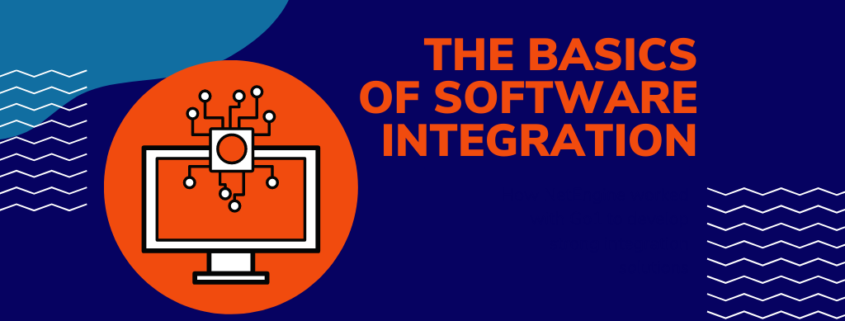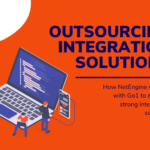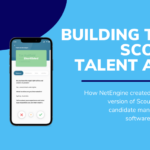How good are apps? They’re everywhere. Whether you’re at work or at home, if you’ve got a problem that needs to be solved, there’s likely an app that can do it for you. But with data stored across platforms, how do you get them to talk to each other and work in conjunction with the different tools that are available.
The problem magnifies at work if your internal and external teams use different apps day-to-day. If your apps don’t talk to one another, how much time is wasted circumventing these processes and manually shuttling data back and forth? Software integration is a common issue facing organisations, regardless of industry or size. If apps don’t have a way to speak to one another, this can lead to a siloed business, with vital information slipping through the cracks.
Thankfully, software integration is now simple, straightforward, and cost-effective. There are countless solutions to help your organisation’s apps and data communicate with one another, and NetEngine is highly skilled at helping you achieve this. This article will focus on the basics of software integration, and how they can help your business run effectively and efficiently.
What is software integration?
Before we dive into how integrating software can help your business achieve quantifiable goals, let’s unpack what we mean when we’re talking about software integration.
Integration is the process of creating a system where two separate pieces of software can communicate with each other. It helps overcome the issue of isolated data by rerouting existing systems to talk to each other and share key information. Integrations can be scalable, so as a business grows, so can its tech capabilities.
While integration approaches differ depending on the size of the organisation, smaller companies without internal development teams often opt for external Software as a Service (SaaS) solutions. This allows them to upgrade their business offering without having to manage the process themselves.
Some organisations, like GO1, are large and have their own development teams but choose to outsource their integrations to teams like NetEngine in order to seamlessly integrate their content and expand their capacity while they prioritise scaling their business.
Having dedicated SaaS specialists integrate your software architecture makes life easier, and as an added perk, many of them make their Application Programming Interface (API) public. This helps you scale the scope of your integrations as your business grows.
What kind of software can be integrated?
Long story short, there are few limits to what kind of software can be integrated into an existing platform. Before we explore that, let’s explore what an API is, and how this can expand your integration possibilities.
The HubSpot team put it very succinctly when they described apps as cities, and the APIs of each app as the directions to access that city. This is how we define native integrations; integrations that are built directly into the interface of the existing app. While native integrations are conveniently adapted into the existing app environment, they are time-consuming to complete and often internal teams only have the capacity to carry out integrations with a few apps.
Often, in order to complete native integrations efficiently and on scale, organisations will get some support from external web plug-ins and software, and won’t have their in-house development teams do that work. In times like this, when you need to integrate software internally to standardise best practice, you’ll need to use Integration Platform as a Service (iPaaS), a form of middleware.
An iPaaS specialises in integrating siloed software. When there are multiple widgets within an organisation that need to talk to one another, an iPaaS is highly effective to align databases and standardise data for everyone that needs to access it. NetEngine is an industry leader when it comes to iPaaS, and we love working with clients to find a tailored software integration solution that fits their needs. We take a hands-on approach to software integration, and believe that workshopping issues with a client helps set actionable goals to help your business grow.
Integration solutions in action
If you think about the amount of personal information you volunteer for different platforms, you’ll get a good picture of the sheer amount of data we process daily. Integrations start by identifying which data is needed to create a cohesive client profile, and then flagging similar data across platforms to ensure all content is in sync. Using an iPaaS, also referred to as middleware, is our method of aligning all relevant content to create a fully integrated solution.
Take GO1 for example, an existing NetEngine integration client. GO1 is a tech unicorn and has the largest e-learning library in the world, with an innovative format of making content discoverable and available through a subscription model. In order to make sure clients’ content was compatible with the e-learning library system, NetEngine used iPaaS to develop integration solutions so their course content would integrate seamlessly with GO1’s API.
As GO1 is a large organisation with their own internal development team, you may think they have no need to outsource their integration solutions. But their strategy was to direct the majority of their internal resources to scaling the business and enriching their interface, and assigned their integrations to external software integrators like NetEngine to increase their capacity and complete work more quickly. NetEngine worked as a dedicated team that worked alongside GO1’s team, to complete integration solutions for GO1’s clients.
This strategy was effective for GO1–through NetEngine, they gained an external software integrator team that allowed them to achieve development goals without compromising their service to their clients or the effectiveness of their software.
The reason they chose NetEngine over an overseas company or freelancer was that they wanted a team that was local, reliable, and great with clients and communication. Though GO1 is a global organisation, their head office is Brisbane, which matched well with our Australia-based developer team.
As we have demonstrated, NetEngine’s integration solutions are used by organisations large and small to increase their business’s capabilities without either managing the process themselves or allocating too much of their internal resources to it.
If you need help scaling, advice on how to approach integrations internally, or a hands-on way to grow your business through our solutions, NetEngine can help. Contact us here to get started!




